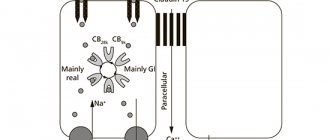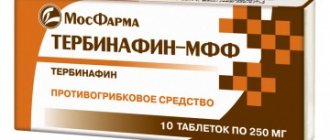Pharmacodynamics and pharmacokinetics
Terazosin is an α1-adrenergic blocker that is capable of selectively blocking α1-adrenergic receptors in the smooth muscles of the celiac vessels, prostate vessels, and the bladder neck. As an antihypertensive drug, it dilates large resistance vessels and reduces peripheral vascular resistance, and activates the RAS (renin-angiotensin-aldosterone) system.
Relaxation of the smooth muscles of the bladder neck and contractile elements of the prostate helps reduce the dysuric phenomenon, for example, with adenoma. Due to a decrease in the level of total cholesterol , triglycerides, and an increase in HDL levels, the lipid profile in plasma is normalized. Long-term therapy leads to regression of left ventricular hypertrophy.
Pharmacokinetics of Terazosin
After oral administration, Terazosin undergoes rapid, almost complete absorption (bioavailability over 90%). Presystemic biotransformation is insignificant, therefore, only 1 hour is needed to achieve maximum plasma concentration. In plasma, 90–94% of the substance is bound to proteins. Metabolism in the liver occurs until the formation of 4 metabolites.
The half-life is no more than 12 hours, approximately 40% is excreted by the kidneys (up to 10% is unchanged Terazosin), the remaining 60% is excreted through the intestines (more than 50% are biodegradation products). If the patient has liver pathology, there may be a decrease in clearance and a prolongation of pharmacological effects.
Instructions for use
Dosage
Upon entering the gastrointestinal tract, the drug is quickly absorbed and begins its therapeutic effect within 1 hour. When treating a cat, it is important to follow the dosage of Terazosin so as not to cause side effects and not harm the health of the animal.
The amount of the drug, depending on the severity of the disease, should be calculated by a specialist in a veterinary clinic. In most cases, it is recommended to give your pet 1 mg of the drug in the first days of treatment, regardless of body weight. This is 0.5 tablets containing 2 mg of terazosin. It is better to take the drug once a day in the evening.
In the future, depending on the results, your veterinarian may recommend increasing or decreasing the dosage.
The positive effect of treatment most often occurs 10-14 days after the start of the therapeutic course. To consolidate the results, you must continue to take Terazosin for another 4-6 weeks. The decision to discontinue the drug should be made by the attending physician.
How to give?
There are several ways to give tablets to your cat. Many veterinarians recommend crushing the medicine and mixing it into liquid food. However, some animals refuse such food.
Therefore, the required amount of medicine can be divided into several parts and given to the cat in portions. To do this, you need to put a piece deep into the animal’s mouth so that it swallows it. To stimulate the swallowing reflex, you can stroke your pet's throat. After all the medicine has been taken, you need to give your pet plenty of water to drink.
During treatment with Terazosin, your pet should always have fresh water in his bowl. In addition, many veterinarians who have problems with urination recommend avoiding dry food, especially during therapy.
Side effects
The use of Terazosin may cause the following undesirable reactions:
- weakness and fatigue;
- drowsiness, anxiety, headaches, dizziness;
- paresthesia (feelings of numbness, tingling);
- decreased libido;
- visual impairment, hearing impairment (noise);
- hypotension , tachycardia , arrhythmia ;
- peripheral edema;
- bronchitis , cough;
- xerostomia , pharyngitis , dyspeptic disorders;
- arthralgia , myalgia ;
- decrease in hemoglobin , as well as hematocrit , development of leukopenia , hypoalbuminemia , hypoproteinemia ;
- allergic reactions are possible ;
- influenza-like syndrome.
Attention! A “first dose phenomenon” may occur , usually accompanied by a decrease , and even orthostatic collapse . This body reaction may occur after the first dose, especially in combination with diuretics or beta-blockers .
Reviews
Reviews about the drug Terazosin are mostly positive.
Marina, Volgograd: “In our family there lives an old cat, everyone’s favorite. As he grew older, he began to have problems with urination, and we were forced to go to a veterinary hospital for help. The drug Terazosin tablets was prescribed.
The pet immediately refused food with the medicine mixed into it. They gave it to him in parts, placed it on the back of his tongue, and he swallowed it himself. Improvement occurred within 10 days, the pet’s well-being improved.”
Roman, Vladivostok: “Despite the fact that our cat was not yet a year old, he began to have problems with his kidneys, and a veterinarian I knew advised him to treat him with Terazosin.
They gave him 1/2 of a crushed tablet with food every evening, he did not refuse food and quickly began to recover. But since the disease was severe, treatment had to be continued for almost 2 months without a break. But now our pet is completely healthy.”
Anastasia, specialist at a veterinary clinic, Chelyabinsk: “Terazosin is a proven drug with good diuretic and antihypertensive properties. They can treat kidney problems and control blood pressure not only in humans, but also in animals.
The main condition for a quick recovery is not to exceed the recommended dosage and not to interrupt treatment. In addition, during the therapeutic course, the animal must be under the supervision of a doctor.”
Overdose
Symptoms
Tachycardia , hypotension , orthostatic collapse .
First aid and treatment
Transfer the patient to a horizontal position so that the head end of the bed is lowered. In addition, intravenous fluid and hypertensive medications are recommended.
It is known that hemodialysis is ineffective, and there is no specific antidote .
Drugs for the treatment of prostate adenoma
BPH medications help relieve lower urinary tract symptoms. According to the recommendations of the European Association of Urology, drugs for the treatment of prostate adenoma are used if patients have moderate symptoms of the disease.
Currently, two groups of drugs are most widely used: alpha blockers and 5-alpha reductase inhibitors. Phosphodiesterase inhibitors and anticholinergic drugs and others are used less frequently.
Alpha blockers
Alpha blockers relax the smooth muscle fibers that make up the prostate and bladder neck, which reduces pressure on the walls of the urethra and expands its lumen. This facilitates the flow of urine from the bladder. Alpha blockers are prescribed to patients with moderate to severe BPH symptoms. It is worth noting that alpha blockers relieve lower urinary tract symptoms, but they do not slow or stop further prostate growth .
Most men report relief of lower urinary tract symptoms, as reflected by a decrease in the I-PSS ( International Prostatic Symptom ) prostatic symptom index by 4-6 units.
The effect of taking alpha blockers develops after 2-3 weeks.
In the human body, there are several types (alpha-1 and alpha-2) and subtypes (alpha-1a, alpha-1b, alpha-1d, etc.) of alpha-adrenergic receptors, which are located not only in the muscle cells of the prostate, but also in other structures of the body, for example, in the heart, blood vessels, lungs. Previously, alpha blockers were used to treat prostate adenoma, which act on all types of receptors, both alpha-1 and alpha-2 adrenergic receptors. In this regard, men often experienced the development of complications. Scientists have found that alpha-1a adrenergic receptors are located in the prostate. After the development of drugs that selectively block alpha-1 adrenergic receptors (selective alpha blockers), it was possible to reduce the number of side effects associated with the use of non-selective drugs (angina pectoris, arrhythmia, etc.).
Short-acting alpha-1 blockers
Prazosin was the first selective alpha-1 blocker approved for the treatment of prostate adenoma. The disadvantages of prazosin, like other short-acting drugs, were the need to take them multiple times during the day and severe arterial hypotension.
Long-acting selective alpha-1 blockers
The European Association of Urology recommends the use of the following long-acting alpha blockers: tamsulosin, alfuzosin, terazosin and doxazosin. These drugs have approximately the same effectiveness and range of side effects. These drugs for the treatment of prostate adenoma require a single dose during the day.
The most common side effects associated with taking alpha blockers: headache, dizziness, weakness, decreased pressure that occurs when moving from a horizontal to a vertical position (usually observed only at the beginning of treatment - the effect of the first dose), drowsiness, nasal congestion and retrograde ejaculation. Although alpha blockers do not cause erectile dysfunction or decreased libido, these side effects have been reported in some cases of these medications. But such a complication as retrograde ejaculation, when sperm during ejaculation moves into the bladder and not into the penis, is more common. However, it is harmless.
Features associated with taking alpha blockers
If you are taking drugs to treat erectile dysfunction, such as Viagra, you should be aware that their combination with alpha blockers can lead to a significant decrease in blood pressure, including collapse and loss of consciousness. Remember that you can take Viagra no earlier than four hours after taking the alpha blocker.
5-alpha reductase inhibitors
5-alpha reductase inhibitors are the second group of drugs for the treatment of prostate adenoma, helping to relieve symptoms of lower urinary symptoms. Two drugs from this group are used to treat prostate adenoma: finasteride and dutasteride. These drugs block the enzyme 5-alpha reductase, which converts testosterone into dihydrotestosterone, which plays a major role in the development of prostate adenoma. The result is a slower growth of the prostate gland and a reduction in its size, which in turn leads to relief of lower urinary tract symptoms. Finasteride blocks the conversion of testosterone to dihydrotestosterone by 70%, and dutasteride by 95%. However, finasteride and dutasteride are not clinically effective in the treatment of prostate adenoma.
The greatest effect from treating prostate adenoma with 5-alpha reductase inhibitors is experienced by men whose prostate gland was significantly enlarged in size before treatment (more than 30 cc). Men taking 5-alpha reductase inhibitors report a 3-point decrease in their prostatic symptoms on the I-PSS scale. Patients with a small prostate size before treatment (less than 30 cc) do not experience a significant improvement in the prostatic symptom index on the I-PSS scale.
The effect of treatment with 5-alpha-reductase inhibitors develops after 6-12 months from the start of taking the drugs. As we know, the size of the prostate does not always correlate with the severity of symptoms of prostate adenoma, so treatment with finasteride or dutasteride does not always give the expected results. 30-50% of patients develop a clinical response to treatment with 5-alpha reductase inhibitors.
The most common side effects of 5-alpha reductase inhibitors: decreased libido (6.4%), impotence (8.1%), impaired ejaculation (3.7%), erection problems, rash in less than one percent of cases, enlarged in size and compaction of the mammary glands.
Features associated with taking 5-alpha reductase inhibitors
Taking finasteride changes the concentration of prostate-specific antigen in the blood towards its decrease. In patients taking 5-alpha reductase inhibitors, the concentration of prostate-specific antigen may decrease by 50%. Prostate-specific antigen is a nonspecific marker of prostate cancer. An increase in the level of prostate-specific antigen in the blood may be the first sign that allows one to suspect a tumor at an early stage and take measures for further diagnosis and treatment. Underestimating the level of prostate-specific antigen in the blood can lead to false-negative screening results for prostate cancer.
To obtain the actual result of an analysis of prostate-specific antigen in the blood of a patient taking finasteride or dutasteride, the doctor multiplies the resulting figure by two.
Taking finasteride is also known to reduce a man's risk of developing non-aggressive prostate cancer, but increases the risk of developing a highly aggressive prostate tumor.
Phosphodiesterase inhibitors
Previously, tadalafil (a phosphodiesterase inhibitor) was used to treat erectile dysfunction in men. In 2011, this drug was approved for the treatment of benign prostatic hyperplasia. One scientific study found that daily use of tadalafil led to significant improvement in lower urinary tract symptoms in men with prostate adenoma.
Using tadalafil with nitrates (nitroglycerin), alpha blockers and other antihypertensive drugs can cause a sharp decrease in blood pressure. In addition, the use of tadalafil is limited in patients with impaired renal and hepatic function. Among the side effects, the most common are headaches and disorders of the gastrointestinal tract, less often - hearing and vision impairment, muscle pain, etc.
Anticholinergic drugs
Anticholinergic drugs for the treatment of prostate adenoma help alleviate symptoms such as urinary incontinence, frequent urination, and urgency, which could not be alleviated with alpha blockers. Doctors sometimes prescribe anticholinergic drugs in combination with alpha blockers to better control BPH symptoms. Taking anticholinergic drugs is associated with a risk of developing acute urinary retention. In addition, the following side effects may occur: blurred vision, constipation, dizziness, dry eyes, dry mouth, headache, gastrointestinal disorders, abdominal pain, urinary tract infections.
Anticholinergic drugs for the treatment of prostate adenoma: tolteridone and oxybutynin.
Combination of drugs for the treatment of prostate adenoma
Often, drug treatment of benign prostatic hyperplasia requires the prescription of a combination of drugs. Men taking the combination of dutasteride and tamsulosin experience greater relief from BPH symptoms than patients taking the drugs alone.
Currently, dosage forms have been developed that include both an alpha blocker and a 5-alpha reductase inhibitor. This dosage form is convenient and requires a single dose.
As a rule, treatment with combination drugs is well tolerated by patients. The side effect profile includes a combination of adverse reactions characteristic of the drugs individually. The most common adverse events with combination therapy are erectile dysfunction (7.4%), retrograde ejaculation (4.2%), decreased libido (3.4%).
As a rule, long-term use of drugs is required, and when they are discontinued, symptoms may return.
Many men refuse to take medications for the treatment of prostate adenoma because they are terribly afraid of developing side effects, primarily those related to sexual function.
Patient history: “The doctor advised me to start treating prostate adenoma with one or more drugs. I can urinate, but the urine stream is weak and sometimes it hurts when I want to urinate a large volume. I read online about two main classes of drugs for the treatment of prostate adenoma: alpha blockers and 5-alpha reductase inhibitors. Some men report significant symptom relief from taking one of the medications, but most report negative effects from the medications.
As I understand it, both groups of drugs affect sexual function to varying degrees... I’m scared even thinking about it.”
Stories of men taking drugs to treat prostate adenoma
“I take the medications that the doctor prescribed for me and so far I have not had any side effects described in the instructions... I have been taking it for about three years. There was a time when it seemed to me that the drug was not working, then I had to double the dose and everything returned to its place...”
“I’ve been taking medications that my doctor recommended for a long time and they help me, but I can only experience a “dry” orgasm, which I really don’t like...”
“I took tamsulosin and it provided me with good urination. The side effects were a decrease in ejaculate volume and terrible dizziness when standing up suddenly…. When I stopped taking it, urination became more frequent up to 13-15 times a day, and the volume of sperm increased significantly. I am now 45 years old and my urologist prescribed me an alpha blocker. From time to time I experience dizziness when climbing sharply, my nose is always stuffy, and oh yes, a “dry” orgasm. The first time it happened, I carried on, thinking it was just a spasm and an orgasm on the way. I was wrong. But the worst thing of all was priapism! (Priapism is a prolonged, persistent, sometimes painful erection that occurs without previous stimulation). At first I was sure that surgical treatment was not for me, but now I’m already thinking about this option.”
“Hello, I have been taking medications for the treatment of prostate adenoma for a long time... Among the side effects, I was periodically bothered by dizziness and nasal congestion. My prostate adenoma symptoms have decreased significantly, and I am glad that I was able to avoid surgery!”
As you can see, not every man will develop side effects, and different patients may experience different adverse reactions. No doctor can say with a hundred percent guarantee whether you will develop this or that side effect.
By making an appointment with your doctor, you can discuss the therapy that is most suitable for you.
During the consultation, you must tell the doctor without concealment all information about your state of health, concomitant diseases, and medications you are taking. This will help the doctor choose the most suitable treatment regimen for you. Back to articles
Terazosin analogues
Level 4 ATX code matches:
Dalfaz
Sonirid Duo
Setegis
Sonizin
Omnik Okas
Omnic
Proflosin
Urorek
Tamsulosin
Adenorm
Omics
Focusin
Analogs of the drug that match the active compound:
- Cornam (dosage 5 mg, package No. 30, price from 800 rub.);
- Setegis (dosage 5 mg, package No. 30, price from 1100 rubles);
- Terazosin-Teva;
- Haytrin.
Another well-known α-adrenolytic , antidysuric drug is Tamsulosin (Terazosin has more side effects). However, the use of Tamsulosin is effective only for prostate adenoma . The drug is Czech-made, the average price for package No. 30 is 560 rubles.
Characteristics of the drug
Older cats often have problems emptying their bladder. Animals that eat only economy-class dry food every day are also at risk. Such cats often suffer from kidney, liver and stomach diseases. Some owners buy cheap food without even suspecting that their pets may get sick.
© shutterstock
To help the owner correct the problem, veterinarians recommend giving the cat Kornam. The international name of the drug is Terazosin, and in pharmacies it is sold under the name Kornam. Available in tablet form. There are two types of tablets, depending on the volume of the active substance.
Dosage Types:
- tablets of 2 mg are yellow in color, flat round in shape with a chamfer, on one side there is a score that allows you to divide the dragee into two equal parts;
- 5 mg tablets are orange-yellow in color and the same shape.
The main active component is terazosin dihydrate hydrochloride.



